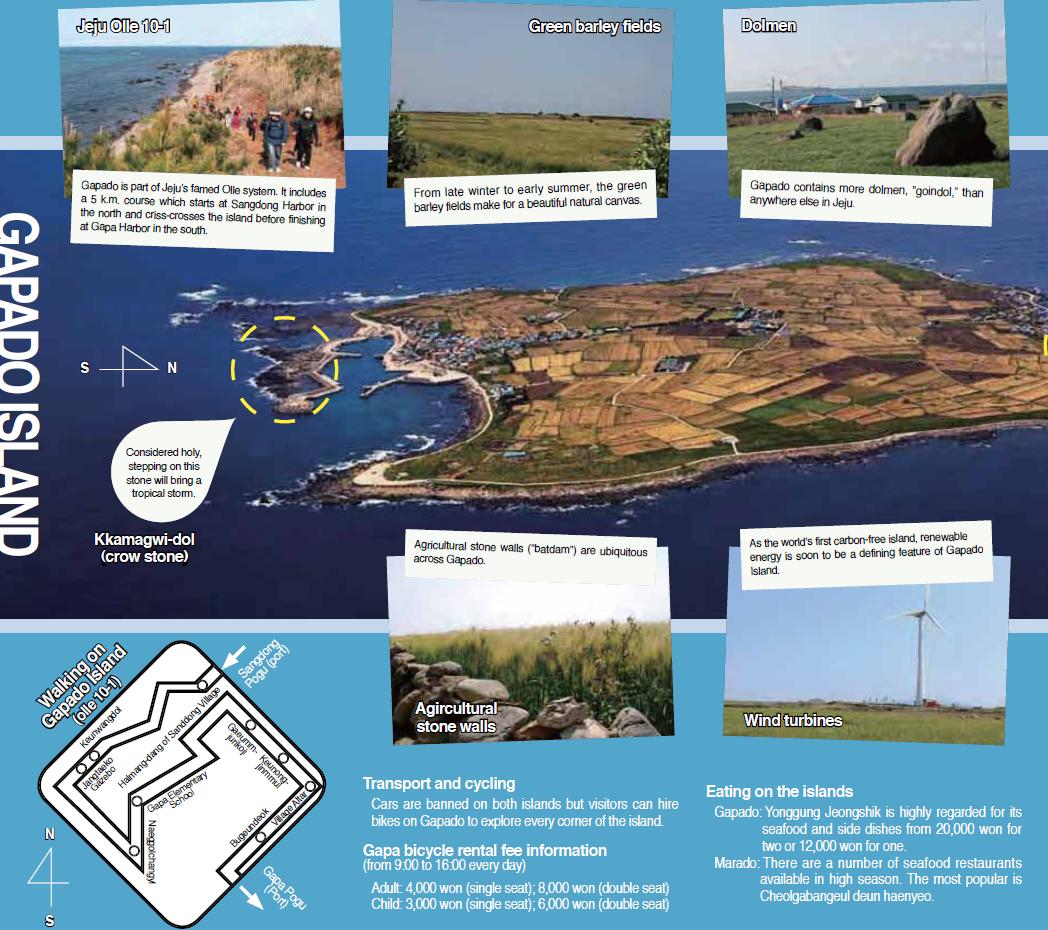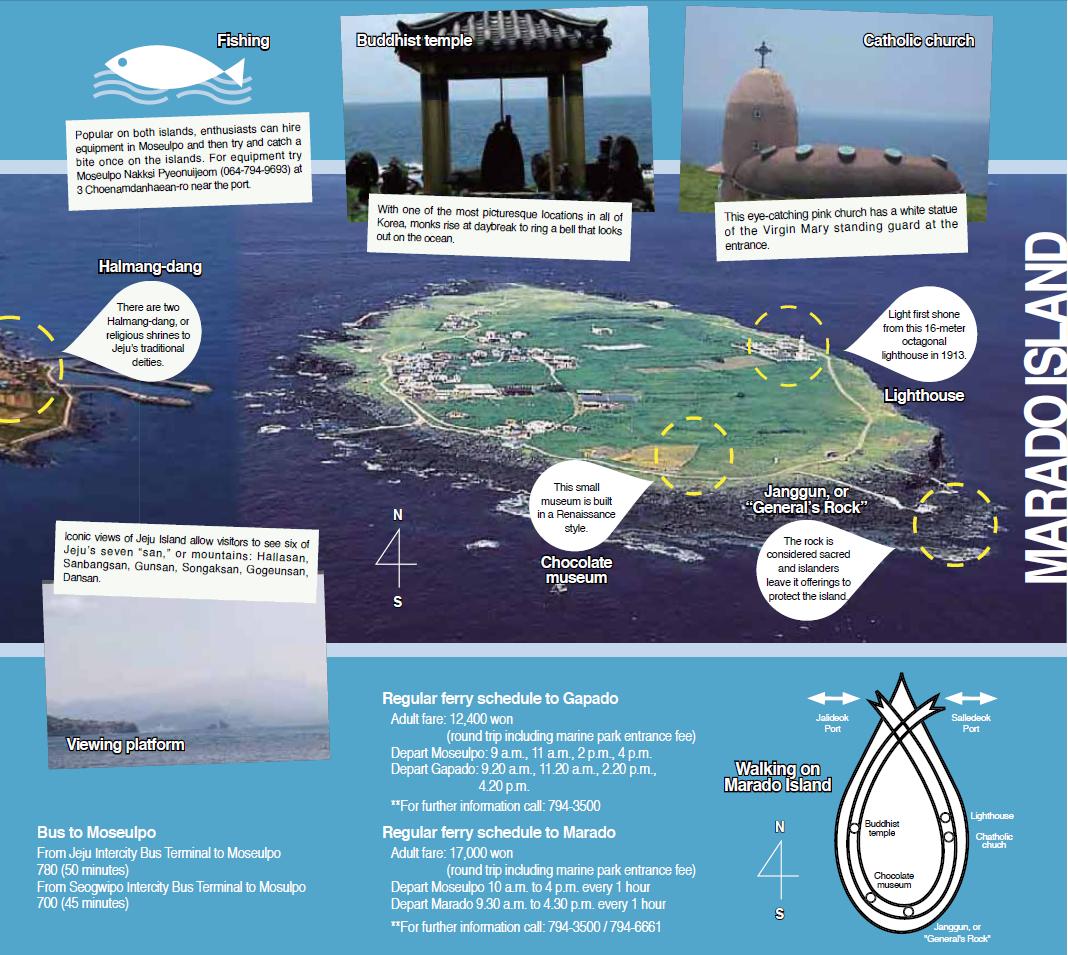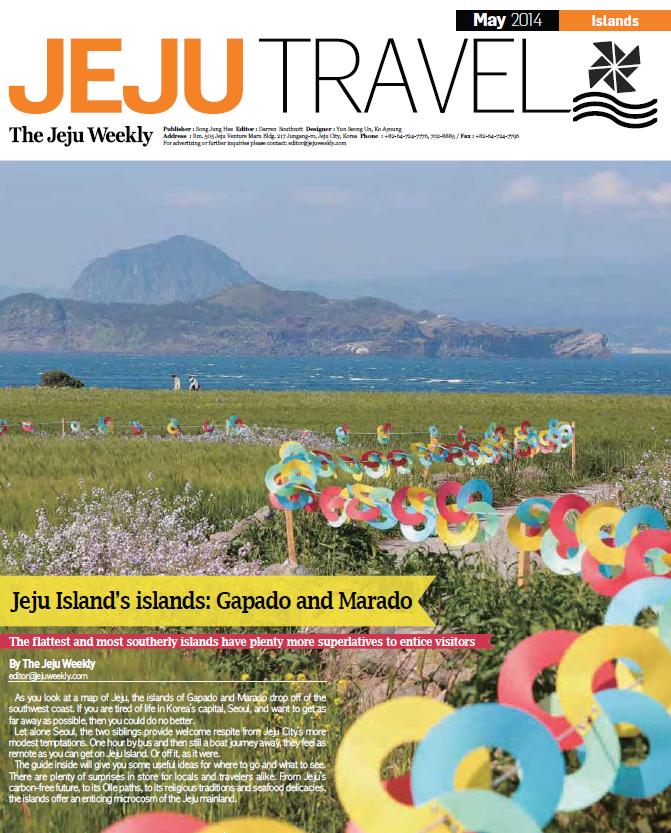|
As you look at a map of Jeju, the islands of Gapado and Marado drop off of the southwest coast. If you are tired of life in Korea’s capital, Seoul, and want to get as far away as possible, then you could do no better.
Let alone Seoul, the two siblings provide welcome respite from Jeju City’s more modest temptations. One hour by bus and then still a boat journey away, they feel as remote as you can get on Jeju Island. Or off it, as it were.
The guide inside will give you some useful ideas for where to go and what to see. There are plenty of surprises in store for locals and travelers alike. From Jeju’s carbon-free future, to its Olle paths, to its religious traditions and seafood delicacies, the islands offer an enticing microcosm of the Jeju mainland.
| |
 |
|
| ▲ Design by Ko Ayoung |
Gapado
Gapado is 0.84 square kilometers and located 5.5 kilometers off the Jeju coast, near Moseulpo port, southwest Jeju. Low lying, the highest point is only 20.5 meters making the views from the flat barley fields to Jeju Island stunning.
It is true that Marado steals Gapado’s thunder as being the most southerly point, but the big brother has some special points of its own. It is striving to be a carbon-free island, the first in the nation, and you can see solar and wind energy across the island. Cars are also absent, so it is good old-fashioned walking for all. Unless you hire a bicycle, of course.
There is also the tradition of barley cultivation, which dates back to 1842 and the Joseon King Heonjong. The fields shine green and golden as the barley ripens and an annual festival marks the spectacle, although it was canceled in 2014 due to the Sewol disaster.
The island has 180,000 pyeong (0.6 square kilometers) of green barley fields and visitors can walk and cycle among them during the festival. The vistas to Jeju Island proper are unrivalled and worth the visit alone.
Jeju Olle 10-1
Gapado is part of Jeju’s famed Olle system. It includes a 5 k.m. course which starts at Sangdong Harbor in the north and criss-crosses the island before finishing at Gapa Harbor in the south.
Green barley fields
From late winter to early summer, the green barley fields make for a beautiful natural canvas.
Dolmen
Gapado contains more dolmen, ”goindol,” than anywhere else in Jeju.
Kkamagwi-dol (crow stone)
Considered holy, stepping on this stone will bring a tropical storm.
Halmang-dang
There are two Halmang-dang, or religious shrines to Jeju’s traditional deities.
Agricultural stone walls
Agricultural stone walls (“batdam”) are ubiquitous across Gapado.
Wind turbines
As the world’s first carbon-free island, renewable energy is soon to be a defining feature of Gapado Island.
Viewing platform
Iconic views of Jeju Island allow visitors to see six of Jeju’s seven “san,” or mountains: Hallasan, Sanbangsan, Gunsan, Songaksan, Gogeunsan, Dansan.
| |
 |
|
| ▲ Design by Ko Ayoung |
Marado
Marado Island, the most southerly, is 11 kilometers off of the Jeju coast and is only 4.2 kilometers in circumference. It has dramatic cliffs and seaviews, rising to 34 meters at its highest.
Gazing south across the water, it is humbling to know that there is nothing but water - give or take an Okinawan island - between you and the Philippines.
First inhabited in the 1880s, it was until then known as “Geumdo,” meaning "forbidden" due its harsh conditions. Sustainable inhabitants today collect energy from the sun and water from the rain.
Marado also boasts a picturesque lighthouse, a temple, a church, even a GS25. Yes, even Marado has one of these. Visitors’ pictures adorn the wall, taken one of Korea’s most remote convenience stores.
Buddhist temple
With one of the most picturesque locations in all of Korea, monks rise at daybreak to ring a bell that looks out on the ocean.
Catholic church
This eye-catching pink church has a white statue of the Virgin Mary standing guard at the entrance.
Lighthouse
Light first shone from this 16-meter octagonal lighthouse in 1913.
Chocolate Museum
This small museum is built in a Renaissance style.
Janggun, or “General’s Rock”
The rock is considered sacred and islanders leave it offerings to protect the island.
Fishing
Popular on both islands, enthusiasts can hire equipment in Moseulpo and then try and catch a bite once on the islands. For equipment try Moseulpo Nakksi Pyeonuijeom (064-794-9693) at 3 Choenamdanhaean-ro near the port.
Transport and cycling
Cars are banned on both islands but visitors can hire bikes on Gapado to explore every corner of the island.
Gapa bicycle rental fee information (from 9:00 to 16:00 every day)
Adult: 4,000 won (single seat); 8,000 won (double seat)
Child: 3,000 won (single seat); 6,000 won (double seat)
Eating on the islands
Gapado: Yonggung Jeongshik is highly regarded for its seafood and side dishes from 20,000 won for two or 12,000 won for one.
Marado: There are a number of seafood restaurants available in high season. The most popular is Cheolgabangeul deun haenyeo.
Bus to Moseulpo
From Jeju Intercity Bus Terminal to Moseulpo780 (50 minutes)
From Seogwipo Intercity Bus Terminal to Mosulpo 700 (45 minutes)
Regular ferry schedule to Gapado
Adult fare: 12,400 won (round trip including marine park entrance fee)
Depart Moseulpo: 9 a.m., 11 a.m., 2 p.m., 4 p.m.
Depart Gapado: 9.20 a.m., 11.20 a.m., 2.20 p.m., 4.20 p.m.
**For further information call: 794-3500
Regular ferry schedule to Marado
Adult fare: 17,000 won (round trip including marine park entrance fee)
Depart Moseulpo 10 a.m. to 4 p.m. every 1 hour
Depart Marado 9.30 a.m. to 4.30 p.m. every 1 hour
**For further information call: 794-3500 / 794-6661 |






















